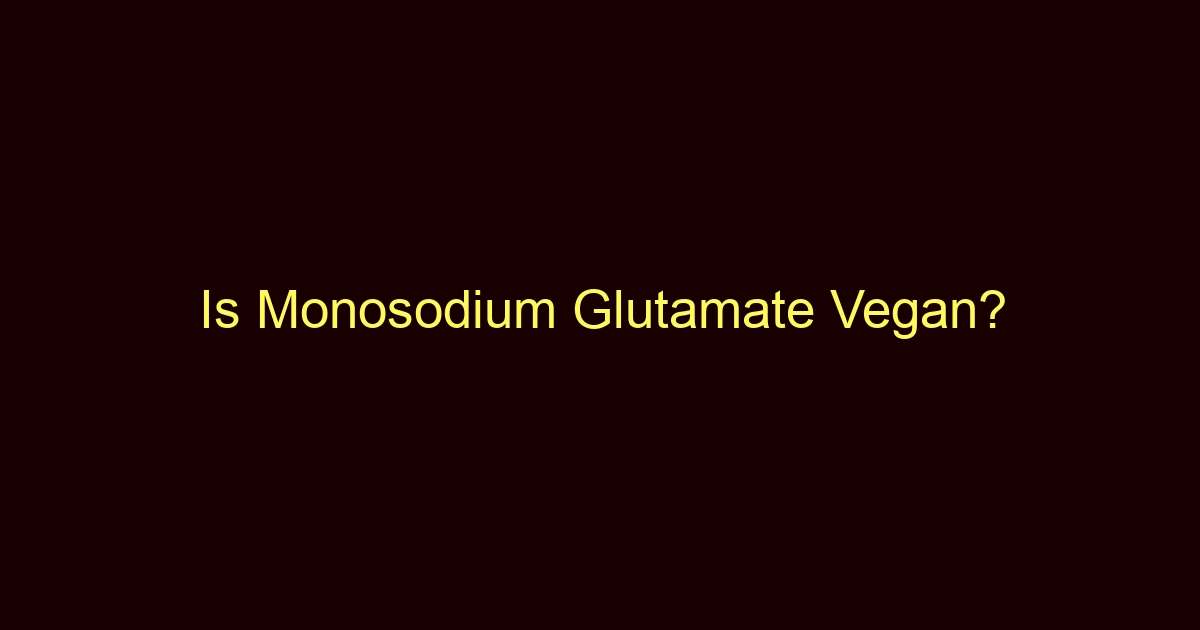Monosodium Glutamate (MSG) is a flavor-enhancing food additive that has been used in cooking for over a century. Though it has been the subject of some controversy, it’s widely used in various cuisines around the world. But is this popular ingredient vegan? Let’s delve deeper to find out.
What is Monosodium Glutamate?
Monosodium Glutamate, better known as MSG, is a sodium salt of glutamic acid, a naturally occurring non-essential amino acid. It’s often used as a flavor enhancer due to its umami (savory) taste. Some even refer to MSG as the fifth basic taste after sweet, sour, bitter, and salty.
MSG was first discovered in Japan in the early 20th century when a scientist found that a common seaweed broth had a different taste than the traditional four known tastes. He isolated this taste to glutamate, and later, MSG was commercialized for its unique ability to boost flavor profiles in cooking.
What is Monosodium Glutamate Made of?
Monosodium Glutamate is made from a fermentation process, much like that used for yogurt, vinegar, and wine. The process involves fermenting starches, sugars, or molasses into glutamic acid, which is then combined with sodium to form MSG.
Despite the fact that MSG was initially extracted from a seaweed broth, today’s commercial production doesn’t rely on any specific plant or animal source. The fermentation process primarily involves bacterial action, and no animal derivatives are used, making MSG a vegan-friendly product.
What is Monosodium Glutamate Used For?
Monosodium Glutamate is primarily used as a flavor enhancer. It imparts a savory, umami taste to foods, making it a popular additive in a wide range of dishes.
You’ll find MSG in processed foods like chips, canned soups, and fast food. It’s also a staple in many Asian cuisines and is commonly found in the form of a white crystalline powder, similar to table salt.
What Foods Contain Monosodium Glutamate?
MSG can be found in many processed foods like instant noodles, chips, ready-to-eat meals, and canned soups. In restaurants, particularly in Asian cooking, MSG is often used to enhance the flavor of dishes like stir-fries, soups, and meat marinades.
It’s also important to note that glutamate is naturally present in many foods such as tomatoes, cheese, and mushrooms, which can contribute to the umami flavor in these foods.
Is Monosodium Glutamate Vegan?
Yes, Monosodium Glutamate is vegan. Its production doesn’t involve the use of any animal products or byproducts. Even though its umami flavor is often associated with meaty dishes, MSG itself is plant-based.
The production process involves the fermentation of starches, sugars, or molasses, without the involvement of animal sources. However, while it’s vegan, it’s worth noting that it’s also a heavily processed ingredient.
Can Vegans Eat Monosodium Glutamate and Why?
Vegans can definitely eat Monosodium Glutamate. It’s a plant-derived flavor enhancer and doesn’t involve any animal products in its production. The unique umami flavor of MSG can help enhance the flavor profile of vegan dishes, making it a useful ingredient in vegan cooking.
However, it’s always important to consider health implications. While the U.S. Food and Drug Administration (FDA) has classified MSG as a food ingredient that’s generally recognized as safe (GRAS), some individuals might have sensitivity to MSG, leading to symptoms like headache, flushing, and sweating.
Health Implications of Monosodium Glutamate
Monosodium Glutamate has been the subject of debate for many years due to claims of adverse reactions. However, according to the FDA, MSG is safe for most people when eaten in normal amounts.
While a small percentage of people might have short-term reactions to MSG, often referred to as “Chinese Restaurant Syndrome,” comprehensive scientific research has not established a definitive link between MSG and these symptoms. Symptoms can include headache, flushing, and sweating.
Monosodium Glutamate in Different Cuisines
The use of Monosodium Glutamate is widespread across many cuisines, most notably in East Asia. MSG brings a depth of flavor to dishes, enhancing their complexity and making them more satisfying.
In Chinese cuisine, MSG is often used in stir-fries, soups, and meat dishes. Japanese cuisine uses it to enhance the flavor of sushi, sauces, and broths. Even in Western cuisines, MSG is sometimes used in processed foods to make them more appetizing.
However, due to the controversy surrounding MSG, some restaurants and food brands choose to avoid it and instead rely on naturally occurring glutamate in foods like tomatoes, mushrooms, and fermented products.
Is Monosodium Glutamate Safe?
Monosodium Glutamate is considered safe for the general population. The FDA has classified MSG as a food ingredient that’s generally recognized as safe (GRAS), and the World Health Organization also classifies it as safe.
However, a small number of people might have a sensitivity to MSG and experience symptoms such as headaches and flushing. If you believe you have a sensitivity to MSG, it’s best to avoid foods containing this additive.
Final Thoughts
Monosodium Glutamate is vegan-friendly. Its production involves no animal products or byproducts, making it a suitable choice for those following a vegan diet. While it is a processed ingredient, it’s generally safe for consumption by most people.
However, like any food additive, it’s best to consume MSG in moderation and as part of a balanced, nutrient-dense diet. As always, individual tolerance can vary, and anyone with a sensitivity or allergy to MSG should avoid it.

